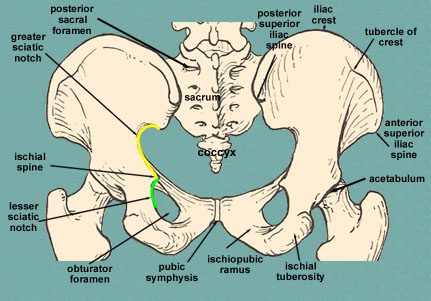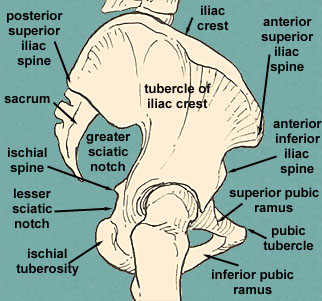A Pain in The Bum
CONDITION: Ischial Tuberosity PainDESCRIPTION:
The ischial tuberosity is a swollen part or broadening of the bone in the frontal portion of the ischium, the lowest of the three major bones that make up each half of the pelvis. As the point of fusion of the ischium and the pubis, it is attached to various muscles and supports the weight of the body when one is sitting. Ischial tuberosity pain may be experienced by a wide range of athletes, including soccer players, cyclists, baseball players, figure skaters, cheerleaders and any type of jumpers or runners. It is often misdiagnosed as ischial bursitis, an extremely painful condition.
 Rear view of the pelvis The Ischial Tuberosity can be seen at the base to the left and right of centre. |
 Side view of the pelvis The Ischial Tuberosity can be seen at the base to the rear of the pelvis (left is view). |
How does an ischial tuberosity injury develop? The ischial tuberosity is the point of origin of the adductor and hamstring muscles of the thigh, as well as the sacrotuberus ligaments. The forceful pull of these muscles, such as can happen during a variety of sports, especially sprinting, as well as a fall or other type of injury, results in a separation or detachment, also called an avulsion, of an open ischial apophysis.
What are the symptoms of ischial tuberosity pain?
The symptoms of ischial tuberosity pain are, plain and simple, “a pain in the bum” Pain on the bottom of the buttock, especially when sitting and running is typical. The area may also be quite tender and sensitive to touch.
Conventional medical treatments may help relieve the symptoms of ischial tuberosity pain, but they do not address the root of the problem. By strengthening structural weaknesses in the body, as natural medicine treatments like Prolotherapy do, pain associated with the ischial tuberosity may be alleviated permanently.
The Response of Modern Medicine
Since ischial tuberosity pain is often misdiagnosed as ischial bursitis, modern medical treatment usually involves, and especially if the patient is an athlete, RICE protocol, which consists of rest, ice, compression and elevation. The problem with this approach is that it does nothing to repair the injured tissue in the area, in this case the sacrotuberous ligaments and/or the hamstring tendon attachment, and, thus, does not alleviate the chronic pain that people with this condition experience. Rest and ice are particularly serious culprits when it comes to soft tissue damage because they decrease circulation to the area, which actually hinders rather than helps the healing process.
Another standard practice of modern medicine is to inject steroids into the area or to prescribe anti-inflammatory medications. However, in the long run, these treatments do more damage than good. Although cortisone shots and anti-inflammatory drugs have been shown to produce short-term pain benefit, both result in long-term loss of function and even more chronic pain by actually inhibiting the healing process of soft tissues. Plus, long-term use of these drugs can lead to other sources of chronic pain, allergies and leaky gut syndrome.
When all else fails, patients who experience chronic pain are often referred to a surgeon. Unfortunately, surgery often makes the problem worse. Surgeons will use x-ray technology as a diagnostic tool, which does not always properly diagnose the pain source. And decisions to remove cartilage tissue often result in arthritis.
The Natural Medicine Approach to Ischial Tuberosity Pain
A better approach is to stimulate repair of the sacrotuberous ligaments and the hamstring tendon attachment with Prolotherapy. Chronic pain is most commonly due to tendon and ligament weakness, as may be the case with ischial tuberosity pain, or cartilage deterioration. The safest and most effective natural medicine treatment for repairing tendon, ligament and cartilage damage is Prolotherapy. In simple terms, Prolotherapy stimulates the body to repair painful areas. It does so by inducing a mild inflammatory reaction in the weakened ligaments, tendons and cartilage. Since the body heals by inflammation, Prolotherapy stimulates healing.




